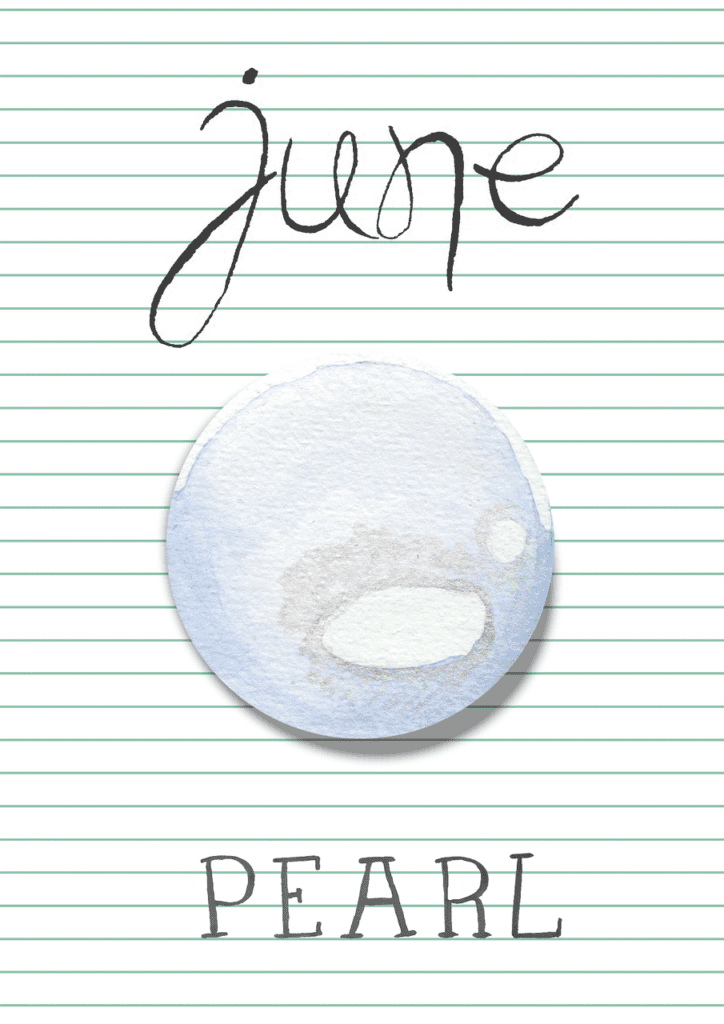Back to: The Magic of Birthstones MB1
Pearl
Pearls are the only gems found within living creatures, both salt and freshwater mollusks. However, most pearls on the market today are cultivated or cultured, since they now occur extremely rarely in nature. While pearls require special care, they have an enduring appeal for jewellery, particularly as the traditional June birthstone.

Symbolism
The finest pearls display unblemished surfaces with even colouring. Thus, there is a natural association with qualities like honesty, purity, and wisdom. Some cultures associate pearls with the divine, believing that pearls were tears shed from heaven, while others placed pearls in the graves of their loved ones. Ancient Chinese lore claims that pearls represent wisdom and power and are carried by dragons.
Colour
While most still think of pearls as white, they are now available in a range of colours including black, green, gold, silver, and various pastels depending on where they were farmed.
Where are Pearls found?
Warm waters is where you’ll often find these pearl birthstones. Saltwater cultured pearls are grown in many areas around the world. Akoya cultured pearl farms are primarily found in Japan and China, South Sea cultured pearls are farmed from the northern coast of Australia through Indonesia to the southern coast of Southeast Asia, with large operations in the Philippines. The Gambier Islands and the Tuamotu Archipelago, both part of French Polynesia, are two locales where the rich black Tahitian pearls are cultured. China is the dominant source of freshwater cultured pearls.
Natural pearls have been found in the Arabian Gulf (Persian Gulf) for at least 5,000 years, while divers have been recovering the June birthstone from the Red Sea since 300 BCE. The Strait of Mannar has been providing pearls since 2000 BCE. Starting in the 16th century, during Spanish colonial rule, large quantities of pearls were recovered from the waters off Mexico, Central America and what is now Venezuela.
Pearl Birthstone care & cleaning
Pearls are 2.5 to 3.0 on the Mohs Scale of hardness, so they are a comparatively soft gem and require special care. Store them separately from other gemstones and metal jewellery to prevent scratching. Never store your pearl birthstones in plastic, plastic emits a chemical that will damage their surface. The best way to clean your June birthstone is to use a soft, damp cloth, after each time you wear your pearl jewellery.
Alexandrite
“Emerald by day, ruby by night,” alexandrite is well-known for displaying one of the most remarkable color changes in the gem world — green in sunlight and red in incandescent light. However, this modern June birthstone is so rare and expensive few people have even seen a natural alexandrite.
Symbolism
Alexandrite was first discovered in Russia in the early 19th century, and quickly became a favorite of Russian royalty. It was named after the future Czar Alexander II. Alexandrite is worn to enhance the intellect and invite good luck.
Colour
When exposed to sunlight, high-quality alexandrite will take on a bluish-green colour reminiscent of emeralds. At night, under incandescent lighting conditions, the gemstone will, instead, appear a purplish-red colour akin to rubies. High-quality stones display clear and distinct colour changes, while the colour of lower-quality stones may appear to have a mixed/muddied appearance.
Where is Alexandrite found?
The spectacular Ural Mountain deposits were eventually mined out, and now most alexandrite comes from Brazil, Sri Lanka and East Africa. The newer deposits contain some fine-quality stones, but many display less-precise colour change and muddier hues than the 19th century Russian alexandrites. Because of its scarcity, especially in larger sizes, fine-quality alexandrite is one of the more expensive coloured gems.
Alexandrite Birthstone care & cleaning
This June birthstone is relatively hard—8.5 on the Mohs scale. It has excellent toughness and no cleavage, which is a tendency to break when struck. This makes it a good choice for rings and other mountings subject to daily wear. An alexandrite engagement ring would be a unique gift for a bride-to-be born in June. Although it is best to clean your June birthstone in warm, soapy water, ultrasonic and steam cleaners are usually safe as well.